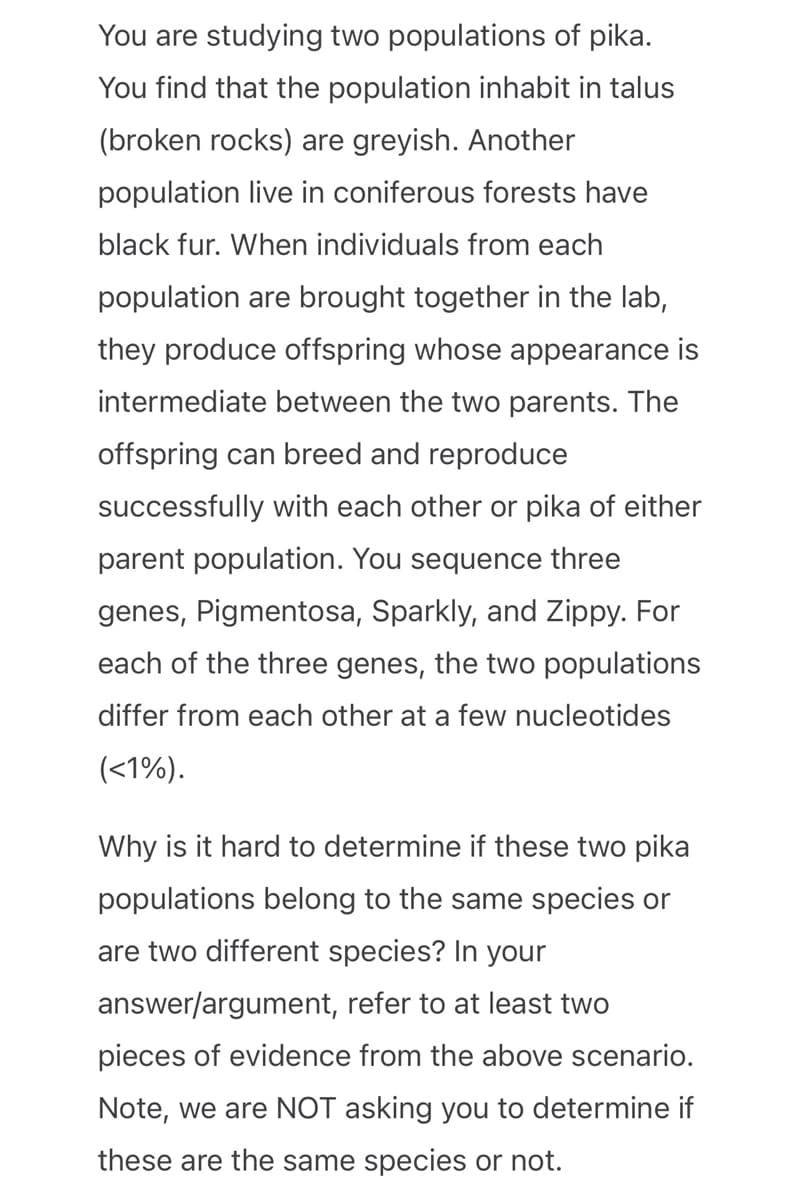You find that the population inhabit in talus (broken rocks) are greyish. Another population live in coniferous forests have black fur. When individuals from each population are brought together in the lab, they produce offspring whose appearance is intermediate between the two parents. The offspring can breed and reproduce successfully with each other or pika of either parent population. You sequence three genes, Pigmentosa, Sparkly, and Zippy. For each of the three genes, the two populations differ from each other at a few nucleotides (<1%).
You find that the population inhabit in talus (broken rocks) are greyish. Another population live in coniferous forests have black fur. When individuals from each population are brought together in the lab, they produce offspring whose appearance is intermediate between the two parents. The offspring can breed and reproduce successfully with each other or pika of either parent population. You sequence three genes, Pigmentosa, Sparkly, and Zippy. For each of the three genes, the two populations differ from each other at a few nucleotides (<1%).
Human Anatomy & Physiology (11th Edition)
11th Edition
ISBN:9780134580999
Author:Elaine N. Marieb, Katja N. Hoehn
Publisher:Elaine N. Marieb, Katja N. Hoehn
Chapter1: The Human Body: An Orientation
Section: Chapter Questions
Problem 1RQ: The correct sequence of levels forming the structural hierarchy is A. (a) organ, organ system,...
Related questions
Topic Video
Question

Transcribed Image Text:You are studying two populations of pika.
You find that the population inhabit in talus
(broken rocks) are greyish. Another
population live in coniferous forests have
black fur. When individuals from each
population are brought together in the lab,
they produce offspring whose appearance is
intermediate between the two parents. The
offspring can breed and reproduce
successfully with each other or pika of either
parent population. You sequence three
genes, Pigmentosa, Sparkly, and Zippy. For
each of the three genes, the two populations
differ from each other at a few nucleotides
(<1%).
Why is it hard to determine if these two pika
populations belong to the same species or
are two different species? In your
answer/argument, refer to at least two
pieces of evidence from the above scenario.
Note, we are NOT asking you to determine if
these are the same species or not.
Expert Solution
This question has been solved!
Explore an expertly crafted, step-by-step solution for a thorough understanding of key concepts.
Step by step
Solved in 4 steps

Knowledge Booster
Learn more about
Need a deep-dive on the concept behind this application? Look no further. Learn more about this topic, biology and related others by exploring similar questions and additional content below.Recommended textbooks for you

Human Anatomy & Physiology (11th Edition)
Biology
ISBN:
9780134580999
Author:
Elaine N. Marieb, Katja N. Hoehn
Publisher:
PEARSON

Biology 2e
Biology
ISBN:
9781947172517
Author:
Matthew Douglas, Jung Choi, Mary Ann Clark
Publisher:
OpenStax

Anatomy & Physiology
Biology
ISBN:
9781259398629
Author:
McKinley, Michael P., O'loughlin, Valerie Dean, Bidle, Theresa Stouter
Publisher:
Mcgraw Hill Education,

Human Anatomy & Physiology (11th Edition)
Biology
ISBN:
9780134580999
Author:
Elaine N. Marieb, Katja N. Hoehn
Publisher:
PEARSON

Biology 2e
Biology
ISBN:
9781947172517
Author:
Matthew Douglas, Jung Choi, Mary Ann Clark
Publisher:
OpenStax

Anatomy & Physiology
Biology
ISBN:
9781259398629
Author:
McKinley, Michael P., O'loughlin, Valerie Dean, Bidle, Theresa Stouter
Publisher:
Mcgraw Hill Education,

Molecular Biology of the Cell (Sixth Edition)
Biology
ISBN:
9780815344322
Author:
Bruce Alberts, Alexander D. Johnson, Julian Lewis, David Morgan, Martin Raff, Keith Roberts, Peter Walter
Publisher:
W. W. Norton & Company

Laboratory Manual For Human Anatomy & Physiology
Biology
ISBN:
9781260159363
Author:
Martin, Terry R., Prentice-craver, Cynthia
Publisher:
McGraw-Hill Publishing Co.

Inquiry Into Life (16th Edition)
Biology
ISBN:
9781260231700
Author:
Sylvia S. Mader, Michael Windelspecht
Publisher:
McGraw Hill Education